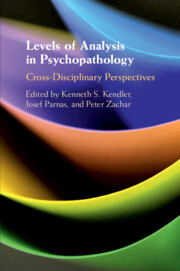Book contents
- Levels of Analysis in Psychopathology
- Advance Praise for Levels of Analysis in Psychopathology
- Levels of Analysis in Psychopathology
- Copyright page
- Contents
- Figures
- Tables
- Contributors
- Preface
- General Introduction
- Part I Neuroscience, Mechanisms, and RDoC
- Part II Phenomenology, Biological Psychology, and the Mind–Body Problem
- Part III Taxonomy, Integration, and Multiple Levels of Explanation
- Section 8
- Section 9
- Section 10
- Section 11
- Section 12
- Section 13
- Section 14
- 40 Introduction
- 41 Psychiatric Discourse: Scientific Reductionism for the Autonomous Person
- 42 Commentary on Stephan Heckers, ‘Psychiatric Discourse: Scientific Reductionism for the Autonomous Person’
- Section 15
- Index
- References
41 - Psychiatric Discourse: Scientific Reductionism for the Autonomous Person
from Section 14
Published online by Cambridge University Press: 02 April 2020
- Levels of Analysis in Psychopathology
- Advance Praise for Levels of Analysis in Psychopathology
- Levels of Analysis in Psychopathology
- Copyright page
- Contents
- Figures
- Tables
- Contributors
- Preface
- General Introduction
- Part I Neuroscience, Mechanisms, and RDoC
- Part II Phenomenology, Biological Psychology, and the Mind–Body Problem
- Part III Taxonomy, Integration, and Multiple Levels of Explanation
- Section 8
- Section 9
- Section 10
- Section 11
- Section 12
- Section 13
- Section 14
- 40 Introduction
- 41 Psychiatric Discourse: Scientific Reductionism for the Autonomous Person
- 42 Commentary on Stephan Heckers, ‘Psychiatric Discourse: Scientific Reductionism for the Autonomous Person’
- Section 15
- Index
- References
Summary
Scientific reductionism is necessary for progress in psychiatry. The psychiatric clinician reduces complex mental states and behaviors into diagnosis and formulation before considering the need for and the modality of treatment. The psychiatric researcher explains human behavior with mechanistic models of disease progression and outcome. The resulting psychiatric discourse is confusing, with competing explanatory models, terminologies, and treatment philosophies. Here I will develop the idea that hypothesis testing in psychiatry is shaped by two questions: 1) How strongly can we reduce mental states and behavior? and 2) How much does the person seek and require treatment?If answers to these questions are aligned, it facilitates research and preserves autonomy. Misalignment impedes scientific progress and leads to wasteful debates. Psychiatry needs to balance scientific reductionism with respect of agency and self-efficacy.
Keywords
- Type
- Chapter
- Information
- Levels of Analysis in PsychopathologyCross-Disciplinary Perspectives, pp. 495 - 509Publisher: Cambridge University PressPrint publication year: 2020

